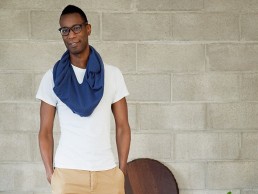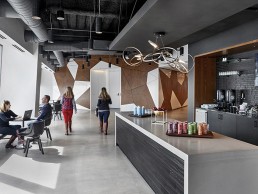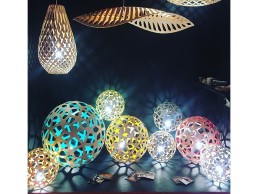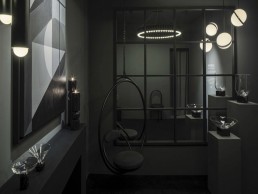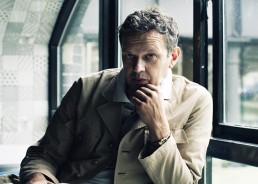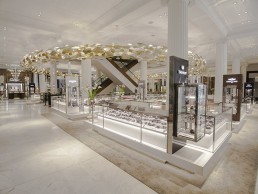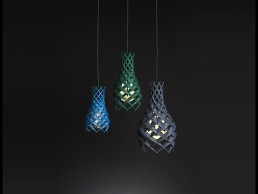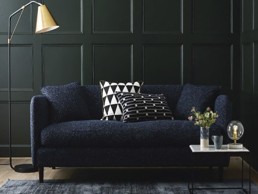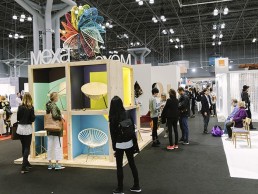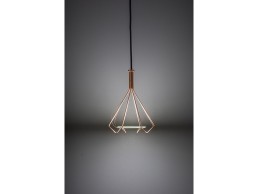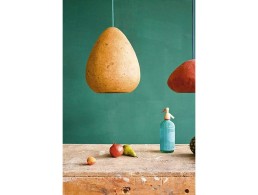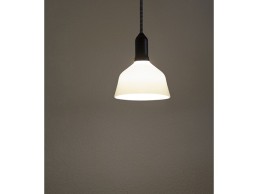Garth Roberts
Garth Roberts founded his studio in 2010 after a series of pop-up studio projects in collaboration with Universities in Milan, Berlin and New York. Before forming his studio, Roberts gained his experience as part of prestigious design teams in North America and Europe, and today his studio works in different fields of product design and creative direction, developing projects for clients such as Glas Itali, Mabeo Furniture, Serralunga, Casamania, and the LRRH_ Art Project.
Since 2009 Roberts has been based in Berlin but continues to work between Milan and New York. Now the creative director of lighting brand Kalmar, Roberts took time out of his busy schedule for a quick Q & A with darc.
Can you tell our readers a little about yourself?
I was born and raised in Canada, where I studied design. After my first year of work experience I decided to take a trip to New York. At that time in my life I absolutely hated travelling, so to this day I don’t know what possessed me to embark upon this adventure. That two-week trip changed what I understood as design and the potential that design had to offer.
When did you realise you wanted a career in design?
I was drawing consistently from a young age, but it wasn’t until I was about seventeen when I understood that creativity could be considered part of my professional aspirations. After this realisation I spent every moment I could trying to understand what design actually was and how my interest in science and history could merge with my creative aspirations.
Who and what inspires / influences you?
In the beginning my main influences came from magazines, I remember waiting with bated breath to get my hands on the most recent monthly design magazine, it was my window to the glamour of design. Now I behave in a way that is the polar opposite of how I did at the start. I almost avoid design magazines completely (of course darc is the exception to that rule!). My current inspiration is how creativity cross-pollinates, so my diet consists of modern dance, art openings and films.
What is it about lighting that specifically appeals to you from a design perspective?
Lighting is the most liberal of all genres related to product, when you’re designing lighting you determine how complex and poetic the final design will be. If it’s done well whatever you decide to do has the potential to be accepted and appreciated. For me this freedom doesn’t really exist in other product groups because the requirements have a direct connection with the human body and anatomy. Lighting brings items to life. If it is done well it calms the nerves.
Can you tell us about some of your most notable projects?
My project history ranges from the more rationally designed projects for Kalmar to more conceptual, expressive works such as the crate collection for Mabeo Furniture. As the creative director of Kalmar I have to consider the brand’s established design history and vintage products. The Hase, Billy and Kilo series of lamps are all examples of this mentality. In pieces like the Quake table for Glas Italia, After Party rug for cc-tapis, Zanotta’s RAW table, the Crate Collection and Mabeo’s Seri Stool, I have more flexibility to express the tension of materials and the sophisticated crudeness of intent in my work.
How would you describe your signature style?
I think my style is quite sophisticated yet basic, with a sense of tension. This tension is embodied in contrasting materials, the use of colour and texture or lack thereof. I like to leave a crude or unstudied undertone to my work. I aim to communicate an uncontrived simplicity and approachability to those that encounter the design.
What trends are you seeing in decorative lighting at the moment and how do you see it continuing to progress?
The attention that was given to lighting as a typology has intensified in the last few years, because of this the variety and quantity of lamp designs have increased dramatically when compared to the past decade. The trends that stand out to my sensitivities are the sculptural ideas expressed via the forms. The lamp is no longer just considered an accent piece; it is now often competing as the focal piece in the interior landscape.
Do you have any collaborations or projects lined up that you can share with us?
We’ve started a few new collaborations; one in particular focuses on using natural fibres. I find this particularly interesting because of its connection to handcraft and the origins of design. I will continue working with cc-tapis, Kalmar Werkstaetten and Mabeo furniture, developing some new projects that expand some of our existing object series and initiate some new directions.
If you could sum up working with light in one sentence what would it be?
Working with light means trying to give a full sensory experience and embody something that borders on intangible to every sense except sight.
Common Interests
(US) - Thirteen years after the 9/11 attacks tore down the Twin Towers in New York City, the new One World Trade Center skyscraper opened on 7 November 2014. The tower is a 104-storey, US$3.9bn skyscraper and the tallest building in America at 1,776ft high.
A culmination of an amazing collaboration between the Port Authority of New York and New Jersey and The Durst Organisation, it was engineered to be the safest and most secure commercial structure in the world, as well as the most recognised and desirable office address in the world. Featuring three million square feet of office space spanning 71 floors, a breath-taking observation deck, grand lobby, and underground tunnel, the building is also LEED Gold Certified. Now more than 70% leased, the office tower includes a roster of more than 26 tenants representing business sectors including media, technology, financial services, advertising and biotechnology.
In February of this year, the opening of One World Commons was announced; a full service amenity space exclusively for the tenants of One World Trade Center. Located on the 64th floor, it serves as a world-class corporate and social hub, purpose-designed for workers to get away from the traditional office, but to also foster workplace creativity, collaboration, learning and development, and ultimately – a sense of place and community. The floor includes: conference, meeting and event rooms available for rent with a state-of-the-art social hub where people can congregate within the building, expanding their community, accelerating their learning and ingenuity and / or enjoying a game of pool.
In charge of bringing One World Commons to life was architectural firm Gensler; in collaboration with lighting design practice SBLD. Gensler has a long-running relationship with The Durst Organisation, having created various unique spaces together throughout New York City, and in 2014 Durst approached Gensler to develop a strategy to attract tenants to One World Trade Center. Through a highly collaborative design process, the architectural firm developed the strategy of creating a common amenity floor, open to all current and future tenants. The whole process from concept through to completion took around two and a half years.
“There were several parties involved in One World Commons and so our challenge was to meet and exceed each of the team’s separate aspirations and input on the final design,” EJ Lee, Principal and Design Director at Gensler New York, tells darc. “We also had to develop something that would attract prospective tenants - offering the best amenities design and experience possible at One World Commons. By working in a highly collaborative and transparent environment with each of these groups, we were able to fluidly define and receive the key parameters that made this project successful.”
The design of One World Commons was an evolutionary process, with the brief changing several times – most specifically during the programmatic and planning concept phases. With each refinement of the program and plan, the look and feel of the design came more and more into focus, until Gensler was able to bring everything together into a single vision. Gensler’s initial design concept was to create a space where technology meets fashion. Elegant materials are featured alongside raw finishes to create a very hospitable environment, inspired by some of the different industries occupying the tower. “The design concept played out really well and has exceeded the expectations of all parties involved,” says Lee.
The decorative lighting specified for One World Commons played a primary role in defining the interior of this project. The first step was to define the lighting object and evaluate its performance before supporting architectural lighting was selected in the form of downlights, wall washers and so on. Decorative products from New York-based lighting brands Gabriel Scott and Stickbulb feature throughout the space, taking on somewhat of a modular system.
“The original gesture called for a single strand of Welles cubes to run the entire length of the space,” Gabriel Kakon of design studio Gabriel Scott, tells darc. “As the project went on there were a few changes to the density of the chandelier and the option of breaking up the strands and creating clusters or clouds at random sizes and distances truly accentuated the organic nature of the fixture. The Gensler team seemed pretty set on a modular system. It appeared that their selection was motivated by the need for a dynamic or sculptural alternative to ordinary neon hallway lighting.
“It was nice to see the Welles reach its full potential as a modular fixture and branch out through the common space hallways. We’ve worked with Gensler a handful of times before, always on interesting projects. This one was particularly exciting, both due to the prestigious and iconic nature of the WTC site, but also given the scale and density of the fixture in question.
“The broken up clusters / randomness and overall asymmetry of the fixture come together in a strong and linear form offering both sculptural and lighting qualities.”
This modular approach to the decorative lighting for One World Commons continued with the specification of Stickbulb fixtures, which was first approached by lighting designers SBLD Studio, who had an interest in certain designs from the Stickbulb X Collection. Two customised versions of the Truss chandelier were required – one elongated version involving six modules of the X concept inspired by hexagonal forms in nature, and another involving two modules. Additionally, several Sky Bang chandeliers from the standard collection were specified. “A studio visit was immediately required so that the lead Gensler designers, SBLD and client could view and approve the light output and quality of our designs,” says Stickbulb's Christopher Beardsley.
“Up until this point X designs had only been offered with signature cast brass fittings but the interior specifications for this project called for polished nickel, requiring a new aesthetic direction for the hardware. A test sample of hand plated nickel proved very successful both in terms of finish and reflective light quality and resulted in a series of fixtures that the client was very pleased with.”
“Both structural and mechanical elements dictated / limited the use of decorative fixtures in One World Commons to some extent,” says Amy Ruffles of SBLD. “We like to give enough space around each decorative fixture so that the designed object and its ambient light can be appreciated. In some cases, the structure of the building, as well as mechanical ducts didn’t allow enough space. Moving, lowering or relocating the fixtures was ultimately inevitable.”
Kakon adds: “There were definitely some conflicting mechanical elements over the 50ft span. But the beauty of the Welles modular fixture is that by working with the architect’s plan, we were able to locate every individual hanging point in order to clear all types of interference – mechanical, structural, decorative etc.”
“Our collaboration with the lighting brands began as we discovered specific fixtures that we thought would be great in the space,” continues Lee. “The Gabriel Scott Welles fixture was a critical element to the design, and maintaining its affect while coordinating with the existing and new architectural obstacles did prove to be challenging. We worked directly with Gabriel Scott to understand the precise flexibility we had in terms of the layout in order to accommodate our specific space constraints.”
For SBLD this project was all about creating a welcoming, warm, comfortable space that you would find in a home, hotel lobby, clubs and so on, as SBLD's Attila Uysal explains: “We weren’t looking for uniform illumination or high light levels, we were mostly interested in discrete pools of light.
“Neither concrete floor nor exposed ceiling were highlighted, the importance was placed on the vertical surfaces, transparency, furniture and decorative light fixtures.
“Bringing visible design elements and objects together is EJ’s expertise and it was a pleasure to analyse selected fixtures for scale, light source and control in order to support the overall design. The LED light source allowed the design team to create a family of light objects.”
For Lee, an amenities space such as One World Commons is a newer concept in commercial development and as such, the Gensler team wasn’t driven by a specific baseline standard for how to design an environment serving multiple types of tenants. “This project allowed us to set a standard we are now seeing others follow.”
“Office work environments have changed,” adds Uysal. “The social aspect is as important as the work space itself. Comfortable, relaxing spaces that you can meet with your colleague or client and continue to work or entertain was a key focus of this project.”
One World Commons was a truly collaborative effort with Gensler working closely with Convene, the operator of the space and The Durst and The Port Authority, which co-manage One World Trade Center. As well as this, Gensler’s relationship with SBLD ensured a cohesive vision. Together the team created an exceptional space that supports how people work today and fosters spontaneous conversation and collaboration.
darc room welcomes over a thousand visitors
(UK) - The very first darc room proved a big success as over a thousand visitors passed through its doors.
Organised by mondo*arc and darc magazines in collaboration with design consultants Light Collective, darc room offered a unique way for exhibitors to showcase their products and for visitors to learn more about lighting. In addition to the exhibitors, the venue in central London offered a magnificent canvas for light installations from darc night, the darc awards / architectural event as well as some exciting examples of light art and inspirational speakers from the design community.
A host of creative and innovative speakers took part in the darc thoughts series of lectures, including Felix Hallwachs, CEO at Little Sun, Dutch artist and innovator Daan Roosegaarde; Croatian Lighting Designer, Dean Skira; Daniel Stromborg, Product Designer at Gensler USA; and Kerem Asfuroglu, Lighting Designer at Speirs + Major.
Exhibitors included Anolis, Applelec, ATEA, atelier sedap, DARK, Delta Light, David Trubridge, EcoLED, EcoSense, Enigma, Filix, Forma, Lamp Lighting, LED Linear, Linea Light, LG OLED, Luci LED, Lumenpulse, molo, Optelma, Radiant, Reggiani, Soraa, tossB, Tom Dixon, Turnlights, WILA and Xicato and more!
*Image: David Trubridge stand, darc room.
Lee Broom unveils ‘On Reflection’ at London Design Festival
(UK) - Acclaimed British Product designer Lee Broom last week unveiled ‘On Reflection’ a surreal modernist tableau set within his Shoreditch flagship store for the London Design Festival 2017. Celebrating his tenth London Design Festival, the exhibition showcased the launch of a capsule collection of limited edition designs from the past decade reinterpreted in black.
On Reflection saw the Shoreditch flagship store completely transformed for the week long event. Broom presented a unique and surprising tableau, which took inspiration from Art Deco and Bauhaus style.
On first appearance visitors to the show were immersed in the dark atmospheric black and charcoal grey room but the scene was not quite as it first appeared to be. Standing in front of the ‘mirrored' interior visitors appeared to cast no reflection.
A layered and thought provoking exhibition, Broom created an identical and parallel room with each object placed precisly in reverse to create the deceiving optical illusion.
A space of two halves, on reflection the true nature of the tableau and its surprising and surreal twist was revealed.
Broom began 2017 with his landmark Milan Design Week show ‘Time Machine’ which revisited designs from the past ten years in a pure all-white palette. Whilst continuing to reflect on an illustrious decade in design and a landmark anniversary year, the new all-black editions for the London Design Festival 2017 revealed a darker dimension.
A mix of limited edition designs which included the Mini Crescent Light, Altar Chair and On The Rock glassware were presented alongside new all-black Carousel and Fulcrum Light editions which will launch to the retail market in November. The all-black Carousel and Fulcrum Light editions are available for pre-order at Lee Broom and through any of the many dealers who represent the Lee Broom brand across the globe.
Bringing to a close a landmark celebratory year, in signature style, Broom also hosted a highly anticipated ten-year rooftop party. With the location remaining secret until 24 hours prior to the party, Broom entertained over 400 guests in the NCP carpark Shoreditch.
Guests to the 10-year design week party, which had an 80s auto park theme, were welcomed by elevator girls John Sizzle (The Glory) and Jonbenet Blonde (Sink The Pink). Music was provided by Andrew Armstrong (Monarchy) with moves by cult voguers Jay Jay Revlon & The House of Revlon.
Tom Dixon to relocate headquarters to Kings Cross
(UK) - Tom Dixon will move from its current home at Portobello Dock to Kings Cross in March 2018.
The British lighting brand will move to The Coal Office, a 17,500sq ft complex - historically a coal distribution centre - to create a new flagship shop, showroom, office, restaurant and café. Part of the new Coal Drops Yard retail quarter, the new Headquarters has further been conceived as a hub for designers and design, with partners to be confirmed in due course.
Originally dating back to 1851, the Coal Office building follows the curve of the Regents Canal and is undergoing restoration as part of the redevelopment of Kings Cross. It is located within Coal Drops Yard, a new shopping quarter set to open as a whole in autumn 2018.
With a focus on fashion, craft and culture, Coal Drops Yard will fuse the traditional with the contemporary, housing a unique mix of established and emerging retailers. Individual and independent shops, signature retail brands and new concepts from home and abroad will come together with cafés, bars, restaurants and public spaces to create a new shopping destination for London.
Tom Dixon says: "For us it was imperative not just to find a new office or shop. It was vital to find a new home. London isn't just another city. It is where it all started. We will use these 17,500 sq feet in this incredible location as a platform to broadcast our latest ideas in interior design, product innovation and experiments in food, functionality and future living."
Craig White, Project Director at Argent (Kings Cross) adds: "We are delighted to announce that Tom Dixon will be moving his eponymous brand to Kings Cross. As one of Britain's greatest creative minds, and indeed one of the world's leading designers, Tom's arrival in the area confirms Kings Cross burgeoning credentials as a global hub of creativity, as a location for Britain and the world's most exciting and forward-looking retailers and as a true destination for shoppers and general visitors alike. We look forward to welcoming all to Coal Drop Yard when it opens in 2018."
The Origin of Wonder, UK
Haberdashery has created the 'Origin of Wonder' sculpture for the Wonder Room at Selfridges & Co on Oxford St, London; a fantastic way to celebrate 10 years since its first installation, coincidentally at the same address back in 2007.
This latest sculpture explores the processes involved in extracting and refining the precious metals and gems found in the jewellery on display at the department store, into finely detailed objects of desire via a series of intricate graphics across more than 1,000 photo-etched brass panels. These are arranged around a 20m diameter circular formation, suspended above Europe's most prestigious retail space.
As the sculpture flows between three distinct chapters: the 'Origin of Wonder', 'Savoir-faire & Craftsmanship' and the 'Illuminated Article' it showcases the organic layers and geological forces involved in the extraction of metallic elements, the highly-industrialised techniques involved in working these raw metals into incredibly detailed and beautiful forms, and finally the finished articles with their precision, detail and sense of desirability.
Installed over a five-night period during out-of-store hours, the sculpture is a perfect example of how the design studio applies a highly creative, narrative-led process through a detailed approach to management and logistics to create a stunning, original artwork in complex environments.
“It was a really difficult space to work within,” Haberdashery’s Ben Rigby tells darc. “The whole space had a finished ceiling in place and behind that ceiling there are sprinkler systems, security cameras, motion detectors and so on, we had to make this huge sculpture hang from as few points as possible, as such it looks as though it is a very light piece, floating in the space.
“The team at Selfridges had seen our work at the House of St. Barnabas and liked the delicacy and aesthetic - the sculpture used similar etched brass panels to those we ended up using in the Wonder Room. This was our only sort of direction in terms of a brief or style, so we took that idea and put it on steroids – creating a much bigger sculpture that was much more technically evolved – there’s a lot more going on in this piece.
“This is our first big public sculpture in London and what we’re most proud of is that it feels as though it’s always been there. The main feedback we’ve had is that it feels as though the room has been built around the sculpture, so we’ve managed to create something that’s truly appropriate for the space and compliments the architecture perfectly.”
Looking at the three sculpture chapters in more detail, the first chapter really focuses on the discovery of the metal elements and as such the panels are quite rough around the edges and less constrained, with the graphics exploring earthy qualities. The second chapter is much more about the ‘can-do’ attitude of the craftsmen who take the metals and work them into a toolkit for creating wonderful objects, such as jewellery. At this stage, the graphics become a bit more refined and you can see patterns that derive from sparks coming off a welding torch, alongside details of the technology used to drill into the metals the craftsmen are working on. The final chapter focuses on the finished article, with everything finely polished and refined, with the graphics highlighting the cogs inside a watch or details taken from the jewels.
“We wanted different patinas on the brass so that you can see the evolution as you walk around the piece,” says Rigby. “The three chapters take us straight from the ground right through to the finished object. We were looking for very soft, light, pastel finishes, which was a challenge in itself as no one we went to seemed to have these finishes available. We had to get the finishes just right, anything too dark would have made the sculpture feel heavy and oppressive.”
The sculpture makes use of custom-designed LED lighting to bring the piece to life. Used to illuminate the graphic panels, the LEDs stand off the main tubular frame and shine back onto the piece, throwing light back. “This really picks off the graphics,” continues Rigby. “We had to make the lighting units easily accessible for maintenance purposes and very flexible in terms of control so as to not detract attention away from the jewellery brands on show. You also get some nice reflections on the ceiling as the light bounces off / goes through the panels.
For Rigby, the sculpture brings a certain unity to the space at Selfridges and gives customers even more of a reason to walk around and explore the space. “There’s so many brands in there competing for customers’ attention that you need to bind them all together somehow and I think the circular nature of the sculpture does just that.”
Plumen launch an exclusive 3D printed shade
(UK) - Plumen push the boundaries of traditional fabrication techniques in their new 3D printed shade Ruche. 3D printing applications are developing at a rapid pace, from in-the-field 3D printed parts for the military to 3D printed houses. And Plumen has explored how it can bring innovative beauty to the lighting category with this emerging technology.
Partnering with Designer and Engineer Hook Phanthasuporn, Plumen explored new forms and aesthetics made possible by the 3D printing process, while looking at how 3D printing can reduce the amount of polluting transportation required to get from fabrication to the end customer.
Plumen looked to create a form that, in keeping with their strong organic theme, had its roots in the natural world. Something that looked like it could have grown from a seed. Something that would look familiar, yet would be impossible to create in any other way than through the 3D printing technique.
Ruche is made up of repeating strips that, like leaf forms, flow from youthful tips to mature, fanned out fins. These fins cut across each other in an impossible configuration that still, to the eye, feel harmonious and natural. Adjusting the repeating forms allows the vessels to grow to larger volumes, harmonising with the various bulb formats in Plumen’s growing range.
Viewed from above, the bulb is barely visible but, like the opening of a flower, the beauty of the bulb is gradually revealed as the eye moves down the shade. Slips of light escape like rays of sun through trees, while the open base allows the brightness of the bulb to fully illuminate the surface below.
Heals to launch new regional flagship store in Birmingham
(UK) - Heal’s is one of the leading brands to open at the new 20,000 sq. ft homewares section on Level 1 at the Mailbox, Birmingham.
Hamish Mansbridge, CEO at Heal’s said: “Our Mailbox showroom will offer the finest in furniture design from Heal’s as well as internationally recognised designers and brands. The shop itself will be a unique retail space that will bring the best of our online offering to Birmingham.”
“Birmingham is now recognised as one of the top shopping destinations in the UK, so Birmingham City Centre and the Mailbox are the perfect platform for Heal’s to promote its premium retail offering within a hugely popular lifestyle location which is well accessible to the wider Midlands region and its incoming visitors.”
As well as aspirational and accessible furniture, Heal’s is renowned for its lighting, decorative accessories and kitchenware and some of the world’s most iconic furniture and lifestyle brands, including, Vitra, Case and Tom Dixon.
Heal’s Birmingham will be the perfect destination for customers to browse its products in an attractive welcoming space, with Heal’s full product portfolio available to view or purchase in-store online.
ICFF Miami changes venue
(US) - The organisers of ICFF Miami have just received notification from the Miami Beach Convention Centre that, due to structural damages caused by Hurricane Irma, they will not be able to provide facilities for ICFF Miami.
Fortunately, ICFF management and South Florida city officials were able to identify alternative space available during the scheduled dates.
ICFF Miami will now be held at the Greater Fort Lauderdale / Broward County Convention Center. Just a short commute north of Miami, this beautiful facility can comfortably and safely accommodate our ICFF exhibitors, attendees and partners.
The original date of the exhibition remains the same.
Viiva Nathalia Mussi
Viiva is inspired by the flat shape and soft, comfortable light of OLED, rejecting the high-tech imagery often associated with glowing screens. Hanging horizontally, the OLED panels disappear into their own thinness, leaving empty the slim wire structure and highlighting the absence of a traditional lamp.
Morphe Crea-re
Morphe lamps are very lightweight and durable. The material used in their production -paper was obtained from recycling old newspapers and ecological, certified water based glue. All these components, as well as the process of lamp formation, are environmentally friendly and ecological. The lamps are compostable.
Bulb LMP Renaud Defrancesco
Defrancesco redrew the lines of the light source’s protective glass in different shades so that Bulb LMP becomes a decorative light in its own right. This project reconsiders and redefines an object of current consumption. The bulb is not only a source of light it is also a source of atmosphere.
A great addition to any living space.

